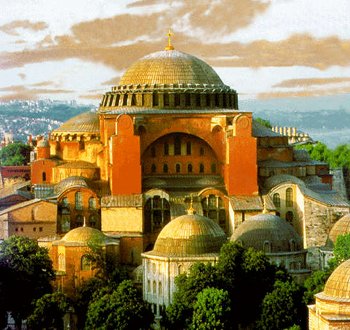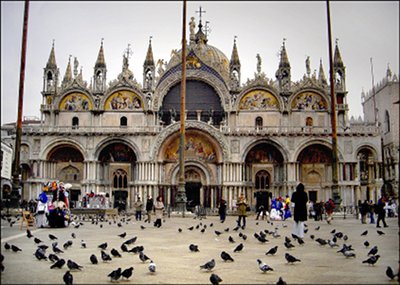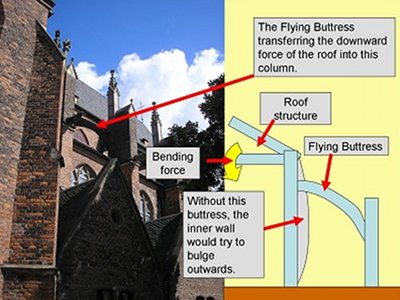Architecture
Explain how Europe benefited from cultural diffusion during the period c. A.D. 1000 - 1500.
Hagia Sophia
Hagia Sophia is one of the greatest surviving examples of Byzantine architecture. Of great artistic value was its decorated interior with mosaics and marble pillars and coverings.
An interesting fact about the original structure of the dome was how the architects were able to place forty windows around the base of the dome. Hagia Sophia is famous for the mystical quality of light that reflects everywhere in the interior of the nave, which gives the dome the appearance of hovering above the nave.
The Hagia Sofia remained the largest cathedral for 1,000 years up until the completion of the cathedral in Seville in Spain.

Artist rendition of Hagia Sophia in Constantinople prior to the Ottoman conquest of 1453.

Interior of the dome of Hagia Sophia. The hanging emblems are islamic and placed after Constantinople was captured by the Ottoman Turks in 1453.

San Marco di Venezia (Church of San Marco at Venice)
At the sack of Constantinople during the Fourth Crusade in 1204, the church was ransacked and desecrated by the Latin Christians. Many relics from the church were looted and sent to Western Europe. After the recapture in 1261 by the Byzantines, the church was in a dilapidated state and remained so until the 1453 conquest of Constantinople by the Muslim Ottoman Turks, who converted it into a mosque.
Crusaders, although aware of Byzantine architectural principles, preferred to use their own Romanesque or Gothic styles in Outremer. In Italy, both Byzantine architecture and mosaics were adopted, as seen in the Church of San Marco at Venice and the Norman cathedrals in Sicily at Cefalu and Montreal.
Gothic Architecture

Notre-Dame de Reims (Our Lady of Rheims) is the cathedral of Reims, where the kings of France were once crowned. It replaces an older church, destroyed by a fire in 1211, which was built on the site of the basilica where Clovis was baptized by Saint Remi, bishop of Reims, in AD 496.
Gothic architecture is a style of architecture which flourished during the high and late medieval period. It evolved from Romanesque architecture and was succeeded by Renaissance architecture.
Originating in 12th-century France and lasting into the 16th century, Gothic architecture was known during the period as
the French Style
(Opus Francigenum), with the term Gothic first appearing during the latter part of the Renaissance
as a stylistic insult. Its characteristic features include the pointed arch, the ribbed vault and the
flying buttress.
Gothic architecture is most familiar as the architecture of many of the great cathedrals, abbeys and parish churches of Europe. It is also the architecture of many castles, palaces, town halls, guild halls, universities, and to a less prominent extent, private dwellings.

Flying Buttress
The defining characteristic of Gothic architecture is the pointed or ogival arch. Arches of this type were used in Islamic architecture before they were used structurally in European architecture, and are thought to have been the inspiration for their use in France, as at Autun Cathedral, which is otherwise stylistically Romanesque. However, it appears that there was probably simultaneously a structural evolution towards the pointed arch in both Islamic and European architechture.
Certainly, Gothic cathedrals with their soaring heights would not have been possible without the medieval crane. Neither could their immense cost be afforded without the increasing growth of a trade and money based economy.
